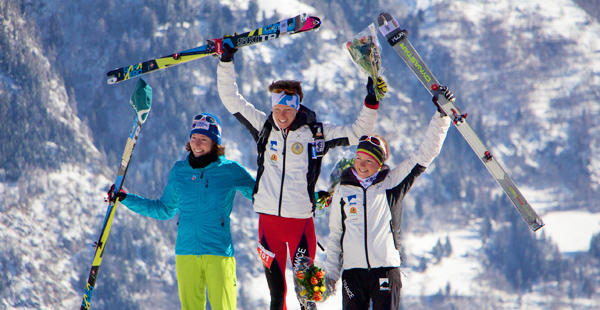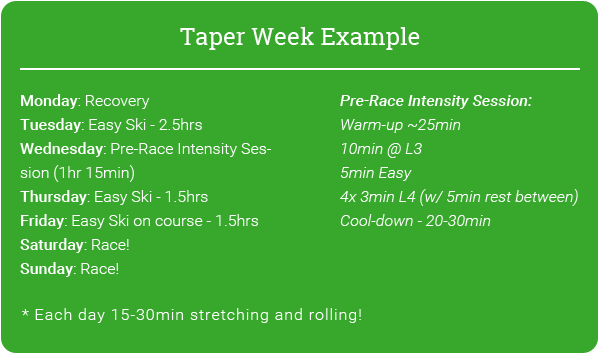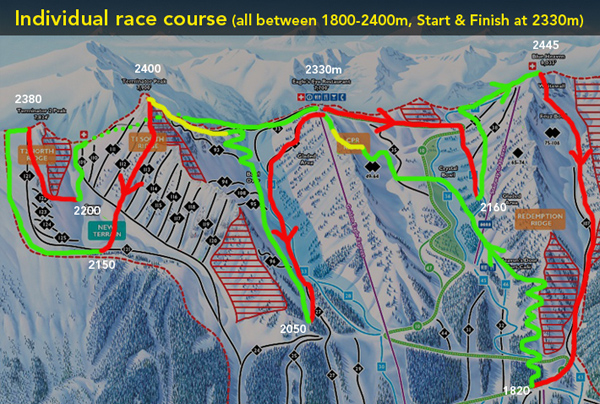After months of training, it can be daunting when the time finally comes for your big race. While it’s not possible to ‘make’ your race by training in the last week or two leading up to it, it’s definitely possible to ‘break’ it if you over do it!
By focusing on your taper, you give yourself the best chance for a successful performance.

Adjusting Your Training – Volume and Intensity
Tapering, to most athletes, means a reduction in volume so we’ll start there. It’s important to adjust your training properly, not just hang up the skis and hit the couch.
Your overall volume (time or vertical – depending on what you measure) should decrease approximately 50% during your taper week. Remember, the training is done, you aren’t going to make any amazing breakthroughs by putting in time the week before the big event.
As important is maintaining the frequency of training and intensity of your sessions. This means if you usually train five days per week, then continue to do so, just make each session shorter. Don’t drop interval workouts from your schedule but adjust them to be less taxing by reducing the number of reps and overall intensity while increasing rest between reps. One of my favourite intensity workouts the week before a race is shown in green below.
Use your reduced training volume wisely, such as to inspect the race course. Depending on the venue, a half-day lift ticket can give you a big advantage for scoping the course. Focus on descents and technical sections. You don’t want to be surprised by a sharp corner when you are racing at your maximum speed!

Maximize Your Recovery
While adjusting volume is the most obvious part of a taper, there is much more to making it effective. Maximizing your recovery routine is a critical component.
Have a look at your schedule and figure out what time you are going to need to wake up the morning of the event, and what time you will need to go to bed the night before for a great night’s sleep. Use the week leading up to the race to adjust your bedtime routine so you get in the habit of getting to sleep on time!
The reduction in training time should also free up extra time to focus on recovery routines like rolling and release, massage, improved nutrition (take the time to prepare healthy meals), and preparing for the race.
Plan Your Race
Previewing a race course, as already mentioned, is critical. It might not always be possible to ski the entire course before race day but do your best to get a copy of the race map and check it out on Google Earth. Are you skiing on piste, open slopes, or in tight trees? Do you have dramatic turns or groomed runs to be aware of?

This becomes part of the overall race strategy. Being aware of the demands of individual climbs will help determine the equipment you use (mostly talking about skins here), how hard you will push in each section, and your nutritional demands.
Practice Your Transitions
While any time is good time to work on your transitions, the taper period is especially great. Going through the correct sequences of various skimo racing transitions will keep your mind sharp towards the race day and sometimes you can discover a bad habit that started to creep in during weeks of pure training.
Once you know the race details, you can specifically focus only on those transitions but pretty much at all times you need to be very efficient in these:
- skins-on
- skins-off
- skinning to boot-packing
- boot-packing to skinning/skiing
If you are unsure about the movement sequences in your transitions watch our playlist of videos below:
Equipment Preparation
Finally, and something easily overlooked, is equipment preparation.
Make sure, several days before, that everything is in proper working order. If your boot cables are frayed or your pole straps disintegrating, don’t wait until the day before the race to repair them. Give yourself a few days just in case the local shop is out of stock or whatever else could go wrong.
We always do a quick check of our boots (cracks/holes)bindings (cracks in the plate or loose screws), skis (waxed/scraped), skins (any glue touchups), and poles (mostly the straps).
Finally, check the weather and wax your skis for the expected conditions. Give yourself plenty of time and do a good job scraping and brushing. Do it when you have access to a bench and vice rather than behind your car at the venue!
12 Week Skimo Training Plan
In addition to our Manual For Ski Mountaineering Racing e-book, we released a very detailed skimo training plan that will help you to reach your best at your goal race – 12 Weeks to Your Best Skimo Race.



Mike Foote says
Great stuff guys, Spot on. Thanks for sharing!